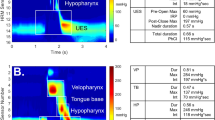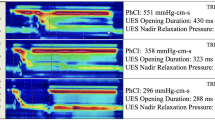Abstract
The effect of body position and gravitational pull on the complex pressure-driven process of pharyngeal swallowing remains unknown. Using high-resolution manometry (HRM), this study aims to identify positional adaptations of pharyngeal physiology by evaluating swallowing pressure patterns in a series of inverted body positions. Ten healthy adults each underwent swallowing tasks with pharyngeal HRM at six body positions using an inversion table (0°[upright], 45°, 90°[supine], 110°, 135°, and 180°[fully inverted]). Repeated measures ANOVA was used to assess impact of position on pressure parameters, and pharyngeal-UES pressure gradients translate. Velopharyngeal pressures varied by position (P < 0.001), with significantly higher pressures generated with inversion ≥90°, compared with upright and 45°. Change in position did not significantly affect common mesopharyngeal pressures or swallowing pressure durations. UES valving mechanisms were preserved during inversion, with subtle variations observed in integral pressures (P = 0.011). Pharyngeal-UES pressure gradients changed with position (P < 0.01), increasing with inversion > 90° compared to upright and 45°. Mechanisms of deglutition may differ with position and relative direction of gravity, particularly when at > 45° inclination. Increased palatal pressure is generated in the upside-down position to achieve nasopharyngeal closure and prevent regurgitation. While other classically measured pressures may not consistently differ with positioning, many individuals exhibit adaptations in pressure gradients when inverted, likely due to a combination of changes in pharyngeal driving force and UES opening mechanisms. Identification of these changes, relative to position, further builds on our understanding of the adaptability of the pharyngeal swallowing system.




Similar content being viewed by others
References
Sears VW Jr., Castell JA, Castell DO. Comparison of effects of upright versus supine body position and liquid versus solid bolus on esophageal pressures in normal humans. Dig Dis Sci. 1990;35(7):857–64.
Martin-Harris B, Jones B. The videofluorographic swallowing study. Phys Med Rehabil Clin N Am. 2008;19(4):769–85. https://doi.org/10.1016/j.pmr.2008.06.004.
Miller A. Deglutition. Physiol Rev. 1982;62(1):129–84.
Jean A. Brain stem control of swallowing: neuronal network and cellular mechanisms. Physiol Rev. 2001;81(2):929–69.
Ertekin C, Aydogdu I. Neurophysiology of swallowing. Clin Neurophysiol. 2003;114(12):2226–44. https://doi.org/10.1016/s1388-2457(03)00237-2.
Shiino Y, Sakai S, Takeishi R, Hayashi H, Watanabe M, Tsujimura T, Magara J, Ito K, Tsukada T, Inoue M. Effect of body posture on involuntary swallow in healthy volunteers. Physiol Behav. 2016;155:250–9. https://doi.org/10.1016/j.physbeh.2015.12.024.
Steele CM, Miller AJ. Sensory input pathways and mechanisms in swallowing: a review. Dysphagia. 2010;25(4):323–33. https://doi.org/10.1007/s00455-010-9301-5.
Humbert IA, German RZ. New directions for understanding neural control in swallowing: the potential and promise of motor learning. Dysphagia. 2013;28(1):1–10. https://doi.org/10.1007/s00455-012-9432-y.
Dantas RO, Kern MK, Massey BT, Dodds WJ, Kahrilas PJ, Brasseur JG, Cook IJ, Lang IM. Effect of swallowed bolus variables on oral and pharyngeal phases of swallowing. Am J Physiol. 1990;258(5):G675–81.
Hoffman MR, Mielens JD, Ciucci MR, Jones CA, Jiang JJ, McCulloch TM. High-resolution manometry of pharyngeal swallow pressure events associated with effortful swallow and the Mendelsohn maneuver. Dysphagia. 2012;27(3):418–26. https://doi.org/10.1007/s00455-011-9385-6.
Kahrilas PJ, Dodds WJ, Hogan WJ. Effect of peristaltic dysfunction on esophageal volume clearance. Gastroenterology. 1988;94(1):73–80.
Perry JL, Bae Y, Kuehn DP. Effect of posture on deglutitive biomechanics in healthy individuals. Dysphagia. 2012;27(1):70–80. https://doi.org/10.1007/s00455-011-9340-6.
Rasley A, Logemann JA, Kahrilas PJ, Rademaker AW, Pauloski BR, Dodds WJ. Prevention of barium aspiration during videofluoroscopic swallowing studies: value of change in posture. AJR Am J Roentgenol. 1993;160(5):1005–9. https://doi.org/10.2214/ajr.160.5.8470567.
Logemann JA, Rademaker AW, Pauloski BR, Kahrilas PJ. Effects of postural change on aspiration in head and neck surgical patients. Otolaryngol Head neck Surg. 1994;110(2):222–7.
Larnert G, Ekberg O. Positioning improves the oral and pharyngeal swallowing function in children with cerebral palsy. Acta Paediatr. 1995;84(6):689–92.
Park BH, Seo JH, Ko MH, Park SH. Effect of 45 degrees reclining sitting posture on swallowing in patients with dysphagia. Yonsei Med J. 2013;54(5):1137–42. https://doi.org/10.3349/ymj.2013.54.5.1137.
Inagaki D, Miyaoka Y, Ashida I, Ueda K, Yamada Y. Influences of body posture on duration of oral swallowing in normal young adults. J Oral Rehabil. 2007;34(6):414–21. https://doi.org/10.1111/j.1365-2842.2007.01737.x.
Inagaki D, Miyaoka Y, Ashida I, Yamada Y. Influence of food properties and body position on swallowing-related muscle activity amplitude. J Oral Rehabil. 2009;36(3):176–83. https://doi.org/10.1111/j.1365-2842.2008.01927.x.
Anagnostara A, Stoeckli S, Weber OM, Kollias SS. Evaluation of the anatomical and functional properties of deglutition with various kinetic high-speed MRI sequences. J Magn Reson Imaging. 2001;14(2):194–9. https://doi.org/10.1002/jmri.1172.
Borgstrom PS, Ekberg O. Peristalsis in pharyngeal constrictor musculature in relation to positioning and gravity. Acta Radiol. 1989;30(2):183–5.
Barkmeier JM, Bielamowicz S, Takeda N, Ludlow CL. Laryngeal activity during upright vs. supine swallowing. J Appl Physiol. 2002;93(2):740–5. https://doi.org/10.1152/japplphysiol.00380.2001.
Johnsson F, Shaw D, Gabb M, Dent J, Cook I. Influence of gravity and body position on normal oropharyngeal swallowing. Am J Physiol. 1995;269(5 Pt 1):G653–8.
Dejaeger E, Pelemans W, Ponette E, Vantrappen G. Effect of body position on deglutition. Dig Dis Sci. 1994;39(4):762–5.
Ingervall B, Lantz B. Significance of gravity on the passage of bolus through the human pharynx. Arch Oral Biol. 1973;18(3):351–6.
Castell JA, Dalton CB, Castell DO. Effects of body position and bolus consistency on the manometric parameters and coordination of the upper esophageal sphincter and pharynx. Dysphagia. 1990;5(4):179–86.
Nakayama E, Tohara H, Hiraba H, Sanpei R, Wakasa H, Ohno S, Kumakura A, Gora K, Abe K, Ueda K. Effects of reclining posture on velopharyngeal closing pressure during swallowing and phonation. J Oral Rehabil. 2013;40(6):450–6. https://doi.org/10.1111/joor.12050.
Fox MR, Bredenoord AJ. Oesophageal high-resolution manometry: moving from research into clinical practice. Gut. 2008;57(3):405–23. https://doi.org/10.1136/gut.2007.127993.
McCulloch TM, Hoffman MR, Ciucci MR. High-resolution manometry of pharyngeal swallow pressure events associated with head turn and chin tuck. Ann Otol Rhinol Laryngol. 2010;119(6):369–76.
Geng ZX, Hoffman MR, Jones CA, McCulloch TM, Jiang JJ. Three-dimensional analysis of pharyngeal high-resolution manometry data. Laryngoscope. 2013;123(7):1746–53. https://doi.org/10.1002/lary.23987.
Jones CA, Hoffman MR, Geng Z, Abdelhalim SM, Jiang JJ, McCulloch TM. Reliability of an automated high-resolution manometry analysis program across expert users, novice users, and speech-language pathologists. JSLHR. 2014;57(3):831–6. https://doi.org/10.1044/2014_JSLHR-S-13-0101.
Walczak CC, Jones CA, McCulloch TM. Pharyngeal pressure and timing during bolus transit. Dysphagia. 2016;31(1):104–14. https://doi.org/10.1007/s00455-016-9743-5.
Nativ-Zeltzer N, Logemann JA, Zecker SG, Kahrilas PJ. Pressure topography metrics for high-resolution pharyngeal-esophageal manofluorography-a normative study of younger and older adults. Neurogastroenterol Motil. 2016;28(5):721–31. https://doi.org/10.1111/nmo.12769.
Jones CA, Ciucci MR, Hammer MJ, McCulloch TM. A multisensor approach to improve manometric analysis of the upper esophageal sphincter. Laryngoscope. 2016;126(3):657–64. https://doi.org/10.1002/lary.25506.
Pal A, Williams RB, Cook IJ, Brasseur JG. Intrabolus pressure gradient identifies pathological constriction in the upper esophageal sphincter during flow. Am J Physiol Gastrointest Liver Physiol. 2003;285(5):G1037–48. https://doi.org/10.1152/ajpgi.00030.2003.
Matsuo K, Palmer JB. Anatomy and physiology of feeding and swallowing: normal and abnormal. Phys Med Rehabil Clin N Am. 2008;19(4):691–707. https://doi.org/10.1016/j.pmr.2008.06.001.
Sutthiprapaporn P, Tanimoto K, Ohtsuka M, Nagasaki T, Iida Y, Katsumata A. Positional changes of oropharyngeal structures due to gravity in the upright and supine positions. DentoMaxilloFacial Radiol. 2008;37(3):130–5. https://doi.org/10.1259/dmfr/31005700.
Smith AM, Battagel JM. Non-apneic snoring and the orthodontist: radiographic pharyngeal dimension changes with supine posture and mandibular protrusion. J. Orthod. 2004;31(2):124–31. https://doi.org/10.1179/146531204225020418.
Perry JL. Variations in velopharyngeal structures between upright and supine positions using upright magnetic resonance imaging. Cleft Palate Craniofacial J. 2011;48(2):123–33. https://doi.org/10.1597/09-256.
Hoffman MR, Ciucci MR, Mielens JD, Jiang JJ, McCulloch TM. Pharyngeal swallow adaptations to bolus volume measured with high-resolution manometry. Laryngoscope. 2010;120(12):2367–73. https://doi.org/10.1002/lary.21150.
Gumbley F, Huckabee ML, Doeltgen SH, Witte U, Moran C. Effects of bolus volume on pharyngeal contact pressure during normal swallowing. Dysphagia. 2008;23(3):280–5. https://doi.org/10.1007/s00455-007-9137-9.
Doeltgen SH, Ong E, Scholten I, Cock C, Omari T. Biomechanical quantification of Mendelsohn maneuver and effortful swallowing on pharyngoesophageal function. Otolaryngol Head Neck Surg. 2017;. https://doi.org/10.1177/0194599817708173.
Acknowledgements
We would like to thank Glen Leverson, PhD, biostatistician, for his consultation on statistical analysis and Kayla Foster, BA, for her assistance in manuscript preparation.
Funding
This study and its authors were supported by the National Institutes of Health Grants DC011130, T32 DC009401 (S.P.R), and T32 GM007507 (C.A.J).
Author information
Authors and Affiliations
Corresponding author
Ethics declarations
Conflict of interest
The authors have no conflicts of interest to declare.
Additional information
Presentation of Manuscript Contents 97th Annual Meeting of the American Broncho-Esophagological Association, COSM, San Diego, CA, on April 26, 2017.
Rights and permissions
About this article
Cite this article
Rosen, S.P., Abdelhalim, S.M., Jones, C.A. et al. Effect of Body Position on Pharyngeal Swallowing Pressures Using High-Resolution Manometry. Dysphagia 33, 389–398 (2018). https://doi.org/10.1007/s00455-017-9866-3
Received:
Accepted:
Published:
Issue Date:
DOI: https://doi.org/10.1007/s00455-017-9866-3




